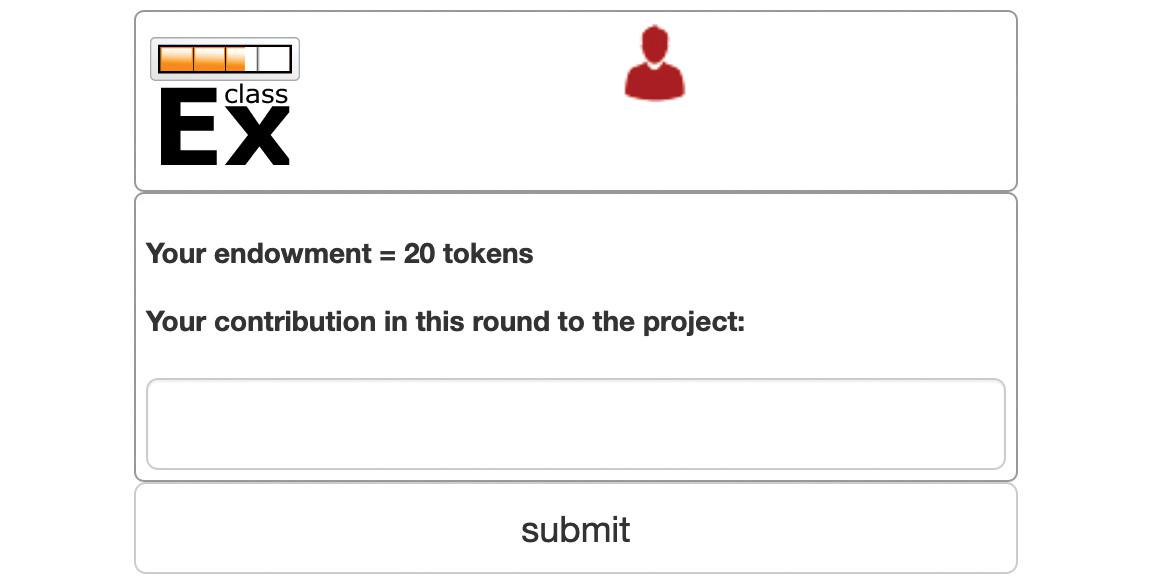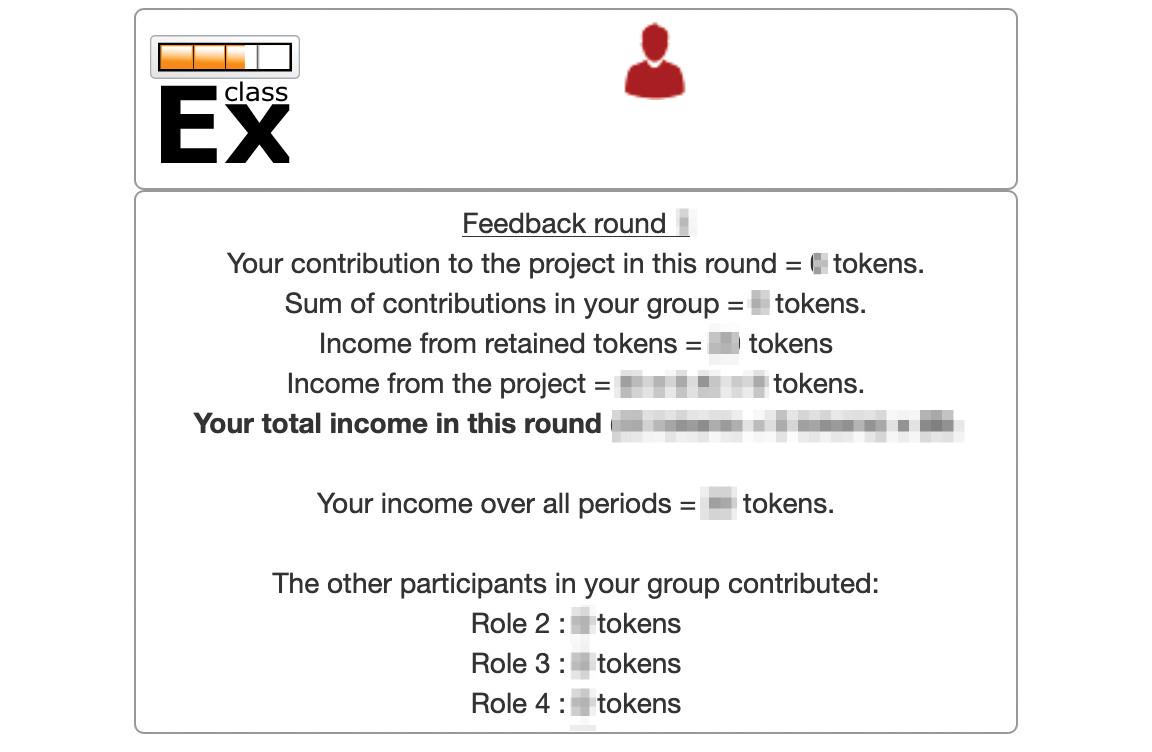Experiment 1 Public goods game
1.1 Introduction
CORE projects
The experiment is covered in:
- Section 4.8 in The Economy 2.0: Microeconomics
- Section 4.7 in The Economy 1.0
- Section 2.9 in Economy, Society, and Public Policy
Concepts in the experiment are related to material in:
Are humans able to cooperate to achieve socially beneficial outcomes, or do they succumb to free-rider incentives?
This activity presents a classic public goods game. Participants receive an endowment of tokens and they must decide how much to contribute to a common pool. The common pool is a productive public good that returns an equal proportion of the sum of contributions multiplied by a number greater than one. The game can be played with and without the possibility to punish free riders.
Experimental evidence shows that contributions tend to decrease through time. However, when people are allowed to punish free riders, contributions bump up and stay relatively constant. Predicted outcomes reflect the graphs in Figures 4.14b and 4.14c in The Economy 2.0: Microeconomics, Figures 4.9a and 4.9b in The Economy 1.0, and Figures 2.9a and 2.9b in Economy, Society, and Public Policy.
The experiment provides students with the experience of a social dilemma situation and gives them an insight into the motivations behind the choice of the individual actors, including free riding, altruism, reciprocity and the intention of cooperation. They can describe the factors that lead to the dilemma situation and analyze the reasons for a decline in contributions to the public good. In addition, it encourages initial intuitive ideas about solutions to the public goods problem.
You may find it useful to read about the experiences of instructors before getting into the detail of setting up the experiment, especially if you are new to running classroom experiments.
This experiment is based on Benedikt Herrmann, Christian Thoni, and Simon Gachter. 2008. ‘Antisocial Punishment Across Societies’. Science 319 (5868): pp. 1362–67.
Citation
Giamattei, Marcus, and Humberto Llavador (2020). ‘Public goods game’. Experiment 1 in The CORE Team, Experiencing Economics. Available at https://www.core-econ.org/experiencing-economics [Accessed on (date)].
Key concepts
This experiment will help students understand the following key concepts:
- Social dilemma
- Public good
- Free rider
- Social punishment
- Altruism
1.2 Requirements
Timing
The experiment can be run with or without punishment. Ten rounds without punishment can be easily run in 5–10 minutes, plus 10–15 minutes for instructions, which could also be sent to students before the class. The introduction of punishments requires some extra time, mainly because of the more detailed instructions. For example, five rounds without punishment followed by five rounds with punishments may add an extra 10–15 minutes, including instructions.
1.3 Description of the experiment
In this experiment, students are divided into groups of four anonymous players and play 10 rounds of the same game. The composition of the group is maintained for all 10 rounds. In each round, students receive an endowment of 20 tokens and must decide how many tokens to contribute to a common project. The total amount of tokens contributed to the group’s project is multiplied by 1.6 and distributed equally among all four members. Therefore, each player receives 0.4 tokens for each token contributed to the project by any member. At the end of the round, students are told the total amount of tokens contributed to the project and their income (in tokens). Their income equals the number of tokens that each student kept for herself or himself plus the tokens she or he received from the project (the same for all four members).
1.4 Step-by-step guide
Detailed instructions
Go to the ‘Quick summary’ section if you have previously run the experiment and just need a brief reminder of the instructions.
We’ve provided two versions of the game. The simplest is a straightforward version of voluntary contributions to a public good (‘Public goods game without punishments’). This version is very easy and fast to run, and provides all the elements you need in order to discuss the key concepts: public good, free riding, reciprocity, altruism, and limits to altruism. If you have enough time, a more elaborate version incorporates the option to punish free riders (‘Public goods game with punishments’). It is still very easy to play, but the instructions are slightly more complex. However, it will provide the opportunity to discuss policy instruments and solutions to free riding and offer a more optimistic view of the social dilemma.
1.5 Student instructions
These are also available in the students’ version.
A PDF of the student instructions and homework questions is also available.
This experiment consists of 10 rounds. You will be in a group of four students and will remain in the same group for all 10 rounds. You will not know who the other three members of your group are. In each round, you will receive 20 tokens and you must decide how many tokens to contribute in a project; you can contribute any number between 0 and 20 tokens. You will keep any remaining tokens for yourself. Your screen will look like Figure A.

Figure A The classEx contribution screen
After all the members of your group have contributed, you will receive feedback on the total contribution to your project and on the tokens you gained in that round (your ‘income’), as well as the number of tokens you have accumulated so far (Figure B).

Figure B The classEx feedback screen
Your reward or payoff will be your final accumulated income at the end of the 10 rounds. Your income in each round consists of the number of tokens you kept for yourself plus 0.4 times the total number of tokens contributed to the project. That is:
\[\text{Income in a round} = (20 − \text{tokens you contribute}) + \\ 0.4 \times \text{total contribution to the project}\]This is because the project produces 1.6 tokens for each token contributed, and all members of the group receive the same return from the project (1.6/4 = 0.4). For example, if the total contribution is 60 tokens, then you and all other members of the group receive 60 × 0.4 = 24 tokens from the project. If you had contributed 15 tokens, then your income in that round would be (20 − 15) + 24 = 29 tokens. If, on the other hand, you had contributed 5 tokens to the project, your income in that round would be (20 − 5) + 24 = 39 tokens.
Remember, your reward or payoff will depend exclusively on your total income.
Remember, all your decisions must be kept private. You must not communicate with other students nor make public announcements, no matter how tempting it might become.
It is very important that you abide by the following rules: All your decisions must be kept private. You must not communicate with other students nor make public announcements, no matter how tempting it might become.
You can use the following questions to test your understanding of the rules.
- Each group member has 20 tokens. Suppose that the other three members of your group contribute nothing to the project.
- What is your income if you contribute nothing?
- What is your income if you contribute 20 tokens?
- Each group member has 20 tokens. Suppose that the other three members contribute 12 tokens in total to the project (excluding your own contribution).
- What is your income if you contribute 20 tokens?
- What is your income if you contribute 0 tokens?
- Each group member has 20 tokens. Suppose that you contribute five tokens to the project.
- What is your income if the total contribution to the project (including yours) is 12 tokens?
- What is your income if the total contribution to the project (including yours) is 48 tokens?
-
- 20
- 8
-
- 12.8
- 24.8
-
- 19.8
- 34.2
1.6 Predictions
Predicted results
The reference example and its data can be accessed from the ‘previous results’ menu in the instructor’s screen of classEx. It is highlighted in bold and always appears first in the list of previous runs.
At the end of the experiment, you will see two graphs on the instructor’s screen. The first will show the average contributions per round for the whole class. The second will show the average contributions per round for each of the participating groups. You may expect to obtain something similar to the graphs in Figures 1.8 and 1.9, which show the results from the reference example in classEx: an experiment without punishments run with a class of 40 students at Pompeu Fabra University in 2019.
1.7 Discussion
A good discussion following the experiment is important. Ask your students the following questions to frame the discussion.
Interpreting the graphs
Comments in the ‘Predictions’, ‘What might go differently’ section, and in The Economy 2.0: Microeconomics (Section 4.8), The Economy 1.0 (Section 4.7), or Economy, Society, and Public Policy (Section 2.9) provide useful further information.
1.8 Homework questions
These questions can be set for students to work on outside the classroom or can be completed and discussed in the classroom. They may help students reflect on their experience and understand theirs and others’ behaviour in the experiment.
Data from your experiment can be downloaded as an Excel file from the ‘data’ menu in the instructor’s screen in classEx. You can use this data to create your own questions. A description of the data variables can be found in the ‘Downloading the data from your experiment’ section.
The following text is also available in the students’ version.
Remember that each participant receives 20 tokens in each round.
- Assume the other three participants in your group are contributing everything in the first round.
- What is your payoff if you contribute everything?
- What is the total payoff in this case for all participants?
- What is your payoff if you contribute nothing?
- What is the total payoff in this case for all participants?
- Now let’s assume the other three participants are contributing 10 tokens in the first round.
- Answer questions 1a–d again.
- What can you conclude about the statement ‘My expectation of the contributions of others’ does not matter in the public goods game.’
Hint: For question 3, which values do you have to change to make it not a social dilemma?
- Free riders
- Describe what is meant by ‘social dilemma’ and ‘free rider’.
- What parameters of the game are responsible for the social dilemma?
1.9 Further reading
Also available in the students’ version.
- ‘Games people play’ (The Economist, 20 January 2015) explains how the proportion of self-interested, cooperators and reciprocators can determine the equilibrium outcome (based on Kurzban and Houser, 2005).
- ‘The usefulness of managers’ (The Economist, 13 October 2019) presents a variation of the game to study the influence of managers in the contribution to public goods (based on Billinger and Rosenbaum).
- ‘Costly punishment across human societies’ (Henrich et al, 2006) shows that punishing deviators is a common feature in all societies. Although punishments vary across societies, more altruistic groups are more willing to pay the cost of punishing non-cooperators.
- CORE The Economy 2.0: Microeconomics, Section 4.8.
- CORE The Economy 1.0, Section 4.7.
- CORE Economy, Society, and Public Policy, Section 2.9.
1.10 Instructor experience
In this section, we hear from instructors about their experience of running the experiment with their students.


